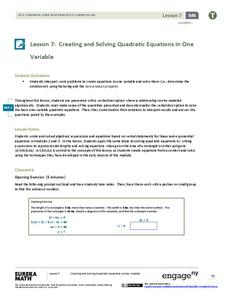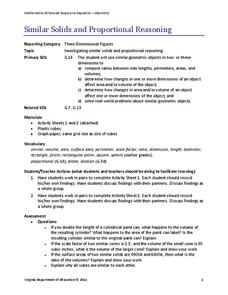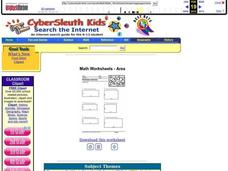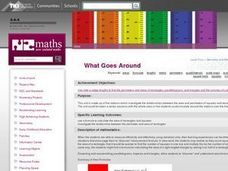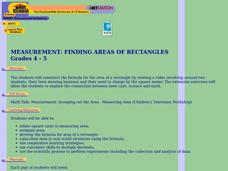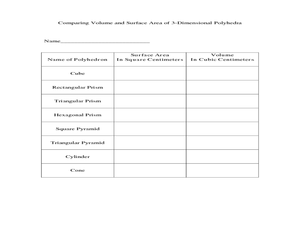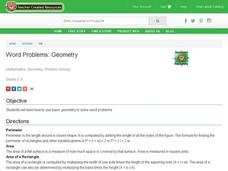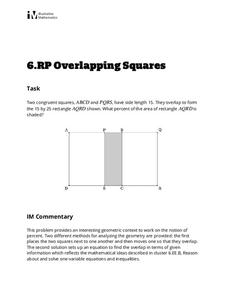Curated OER
Geometry: Area
Students visit various websites to calculate the area of circles, triangles, rectangles, trapezoids, and parallelograms. They explore math problems and play interactive games dealing with geometry.
EngageNY
Problem Solving and the Coordinate Plane
Class members investigate rectangles on the coordinate plane. They determine the length of line segments in the coordinate plane with the same x-coordinate or same y-coordinate and then solve geometric problems involving perimeter...
EngageNY
Creating and Solving Quadratic Equations in One Variable
Give your classes practice at modeling using quadratic models with a resource that uses area and integer problems to allow individuals to create second degree polynomials. Young mathematicians solve equations using factoring and then...
Virginia Department of Education
Similar Solids and Proportional Reasoning
Double the dimensions, quadruple the surface area. Pairs build similar prisms and compare the ratios of their surface areas and volumes to the ratio of the heights. Given two similar cones, partners determine the ratios of the lateral...
Curated OER
Rectangular Gardens
Learners create a rectangular garden using paper and tiles. In this geometry lesson, students investigate the largest possible rectangle that can be created given specific boundaries. They use grid paper to draw the rectangles creating a...
Curated OER
Building Storm Shelters
Sixth graders explore area and perimeter. In this online interactive area and perimeter instructional activity, 6th graders investigate why the perimeter of rectangles can vary considerably even when the area is held constant. Students...
Curated OER
Perimeter and Area
In this math worksheet, students find the area of 6 rectangles. Although the title indicates otherwise, students are not asked to calculate perimeters. There is no instruction on the page.
Curated OER
What Goes Around
Fourth graders investigate the relationships between the area and perimeters of squares and rectangles. They calculate the perimeter of rectangles and squares using a formula. Students investigate the relationship between the perimeter...
Curated OER
Acoustical Ceiling
Students investigate acoustical ceilings. In this acoustical ceilings lesson, students construct a blueprint for an acoustical ceiling. Students use area and perimeter of rectangles to construct their blueprint. ...
Curated OER
Finding Patterns in Tiles
Students explore perimeter and area of rectangles. In this rectangular lesson, students use tiles to discover the formulas for perimeter and area. Students solve for area.
Curated OER
Investigating Scale Factors with the Geometer's Sketchpad
Students use Geometer's Sketchpad to examine the scale factor when in is applied to the length of a figure's sides. They look at how the scale factor affects the side lengths, perimeter, and area of the figure that result. They work with...
Curated OER
Money Math
Students explore a story about a room decoration activity to learn about measurements and area. In this measurement lesson, students listen to a story about a boy who is redecorating his bedroom. Students discuss the story and work in...
Curated OER
Candy Bar Measurements
Geometers explore mathematics by completing an object measurement worksheet. They utilize a variety of candy bars and rulers to conduct a measurement experiment in class. They complete worksheets as a group based on the measurement...
Curated OER
Perimeter and Area of Rectangles
Sixth graders solve for the area and perimeter. In this geometry lesson, 6th graders investigate polygons and use a formula to find the area and perimeter. They find the area and perimeter of various polygons.
Curated OER
Measurement: Finding Areas of Rectangles
Students construct the formula for the area of a rectangle.
Curated OER
The Value of Volume
Students measure the perimeter and area of their polygons. In this geometry lesson plan, students calculate the volume and area using the correct tools. They calculate the time and temperature and the perimeter and side lengths of...
Curated OER
Quadrilateral Attributes
Students classify quadrilaterals. In this quadrilateral lesson, students identify the characteristics of quadrilaterals. They write their findings in a journal. Students use geoboards to create quadrilaterals from given descriptions.
Curated OER
Word Problems: Geometry
Students solve word problems by using basic geometry. In this geometry lesson, students use geometric formulas to find the perimeter, area, and volume of objects. Students complete a worksheet.
Alabama Learning Exchange
Dog Gone Again!
Here is a real-life lesson! Learners must plan the dimensions of a rectangular fence to reign in a runaway dog. They survey what shape and size fence is needed and use formulas to find perimeter and area of the fence. They explore what...
Curated OER
Measurement Investigations 1
Fifth graders find perimeters, areas, and volumes of everyday objects and state the precision. They work in small groups in order to take measurements, perform calculations, and write a group report about the investigation.
Curated OER
Measuring with Mathematics
Eighth graders discover how the change in the dimensions of a shape cause a change in the overall area of the shape, but the perimeter stay the same. They, in groups, go out to the playground and construct large areas using stakes and rope.
Curated OER
Karen's Tiles
Students investigate how perimeter changes as area changes to see the relation between area and perimeter for similar shapes. They then students answer the question if the area of the rectangle increase, does its perimeter have to increase?
Curated OER
Interior Designer for a Day
Seventh graders organize a 20 x 17 room with a given set of furniture pieces. Arrangement is to be based on maximum comfort and practicality. This lesson is a good way to teach and reinforce the mathematical concept of area.
Illustrative Mathematics
Overlapping Squares
The objective of this activity is to find the percent of the area of a two squares overlapping. Mathematicians find the ratio of area for the part that overlaps to the rectangle formed. The final answer is a percent as a rate per 100....


